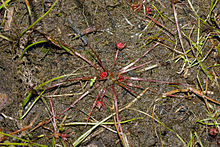
Back Trithuria BS Trithuria Catalan Trithuria CEB Trithuria Czech Trithuria Spanish خزهوشها FA Trithuria Croatian Trithuria Italian 트리투리아속 Korean Trithuria Dutch
It has been suggested that Hydatellales be merged into this article. (Discuss) Proposed since November 2024. |
It has been suggested that Hydatellaceae be merged into this article. (Discuss) Proposed since November 2024. |
| Trithuria | |
|---|---|

| |
| Complete Trithuria submersa specimen | |
| Scientific classification | |
| Kingdom: | Plantae |
| Clade: | Tracheophytes |
| Clade: | Angiosperms |
| Order: | Nymphaeales |
| Family: | Hydatellaceae |
| Genus: | Trithuria Hook.f. |
| Type species | |
| Trithuria submersa | |
| Synonyms[1] | |
| |
Trithuria is a genus of small ephemeral aquatic herb that represent the only members of the family Hydatellaceae found in India, Australia, and New Zealand.[1][2] Almost all described species of Trithuria are found in Australia, with the exception of T. inconspicua and T. konkanensis, from New Zealand and India respectively.[3][4] Until DNA sequence data and a reinterpretation of morphology proved otherwise, these plants were believed to be monocots related to the grasses (Poaceae). They are unique in being the only plants besides two members of Triuridaceae (Lacandonia schizmatica and L. braziliana) in which the stamens are centred and surrounded by the pistils; in Hydatellaceae the resulting 'flowers' may instead represent condensed inflorescences or non-flowers.[5]
These diminutive, superficially moss-like, aquatic plants are the closest living relatives of a clade comprising two closely related water-lily families Nymphaeaceae and Cabombaceae.[6] Together, these three families compose the order Nymphaeales in the APG III system of flowering plant classification. Trithuria (Hydatellaceae) diverged from the rest of Nymphaeales soon after Nymphaeales diverged from its sister taxon, although the crown clade evolved relatively recently, in the early Miocene (~19 Ma;[7]). The order as a whole is the sister group of all flowering plants except Amborellales.
Trithuria exhibits a remarkable similarity to Centrolepis and species of both genera were mistaken for members of the other genus.[8]


- ^ a b Kew World Checklist of Selected Plant Families
- ^ Marques, Isabel; Montgomery, Sean A.; Barker, Michael S.; Macfarlane, Terry D.; Conran, John G.; Catalán, Pilar; Rieseberg, Loren H.; Rudall, Paula J.; Graham, Sean W. (2016-04-01). "Transcriptome-derived evidence supports recent polyploidization and a major phylogeographic division in Trithuria submersa (Hydatellaceae, Nymphaeales)". New Phytologist. 210 (1): 310–323. Bibcode:2016NewPh.210..310M. doi:10.1111/nph.13755. ISSN 1469-8137. PMID 26612464.
- ^ Dmitry D. Sokoloff, Margarita V. Remizowa, Terry D. Macfarlane, and Paula J. Rudall. 2008. "Classification of the early-divergent angiosperm family Hydatellaceae: one genus instead of two, four new species and sexual dimorphism in dioecious taxa". Taxon 57(1):179-200.
- ^ Yadav SR, Janarthanam MK. 1995 Trithuria konkanensis (Hydatellaceae), eine neue Art aus Indien. Aqua Planta 20. (3): 91-97 (1995).
- ^ Rudall, Paula J. (February 4, 2016). "Inside-out flowers of Lacandonia brasiliana (Triuridaceae) provide new insights into fundamental aspects of floral patterning". PeerJ. 4: e1653. doi:10.7717/peerj.1653. PMC 4748704. PMID 26870611.
- ^ Else Marie Friis & Peter Crane (15 March 2007), "Botany: New home for tiny aquatics", Nature, 446 (7133): 269–270, Bibcode:2007Natur.446..269F, doi:10.1038/446269a, PMID 17361167
- ^ Iles, William J D; Lee, Christopher; Sokoloff, Dmitry D; Remizowa, Margarita V; Yadav, Shrirang R; Barrett, Matthew D; Barrett, Russell L; Macfarlane, Terry D; Rudall, Paula J; Graham, Sean W (2014). "Reconstructing the age and historical biogeography of the ancient flowering-plant family Hydatellaceae (Nymphaeales)". BMC Evolutionary Biology. 14 (1). Springer Science and Business Media LLC: 102. Bibcode:2014BMCEE..14..102I. doi:10.1186/1471-2148-14-102. ISSN 1471-2148. PMC 4030046. PMID 24884487.
- ^ Sokoloff, D. D., Remizowa, M. V., Linder, H. P., & Rudall, P. J. (2009). "Morphology and development of the gynoecium in Centrolepidaceae: the most remarkable range of variation in Poales." American Journal of Botany, 96(11), 1925-1940.